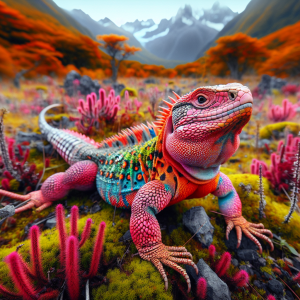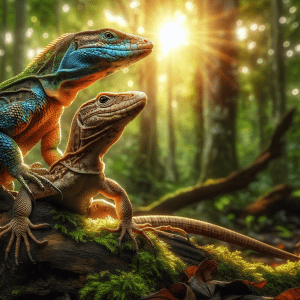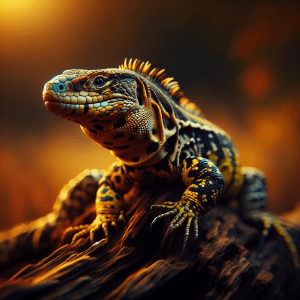Introduction: Understanding South American Lizards
As a leading expert on South American lizards, I’m thrilled to delve into the fascinating world of these reptiles with you. Picture this: the dense rainforests of the Amazon, teeming with life, echoing with the rustle of leaves. Here, amidst the lush greenery, South American lizards thrive in their natural habitats.
These incredible creatures have evolved unique adaptations to navigate the diverse climates of the region. From the vibrant hues of the chameleon-like anoles to the impressive size of the green iguanas, each species has its own story to tell. Did you know that some lizards can change color to blend into their surroundings, camouflaging themselves from predators?
But it’s not all sunshine and rainbows for these reptiles. Climate change poses a significant threat to their existence, altering the delicate balance of ecosystems they rely on. As temperatures rise and habitats shrink, conservation efforts become more crucial than ever. How can we ensure the survival of these remarkable creatures in the face of such challenges?
Exploring the world of South American lizards opens up a realm of wonders and mysteries waiting to be uncovered. Join me on this journey as we unravel the secrets of these captivating reptiles and learn how we can protect their future. Together, let’s embark on an adventure into the wild world of South American lizards.
Climate Factors for South American Lizards
When it comes to the climate factors that influence South American lizards, it’s like being a detective in a thrilling mystery novel. Picture this: these incredible reptiles are the ultimate survivors, adapting to a wide range of climates across the continent. From the steamy rainforests to the arid deserts, they’ve mastered the art of thriving in diverse environments.
Imagine yourself in the lush Amazon rainforest, surrounded by the vibrant sounds of nature. The humidity hangs heavy in the air, creating the perfect sauna-like conditions for some lizard species to flourish. These moisture-loving lizards have evolved to embrace the constant warmth and abundant rainfall, blending seamlessly with their verdant surroundings.
In contrast, journey to the sun-scorched deserts of the Atacama, where the blazing sun beats down mercilessly. Here, you’ll find lizards that have adapted to the extreme heat, their scales reflecting sunlight and their bodies conserving precious moisture. It’s a harsh landscape, but these resilient creatures have found their niche, carving out a niche in this unforgiving environment.
As you delve deeper into the world of South American lizards and their climate preferences, you begin to appreciate the intricate dance between these reptiles and their surroundings. Each species has its own unique story to tell, a tale of survival against the odds. It’s a captivating journey of discovery that sheds light on the remarkable adaptability and resilience of these fascinating creatures.
Habitat Types and Preferences
When it comes to the habitat types and preferences of South American lizards, it’s truly fascinating. These creatures are so diverse in where they call home. Just imagine venturing into the lush Amazon rainforest and stumbling upon an emerald tree boa sunning itself in the canopy. Or picture trekking through the arid deserts of the Atacama and spotting a colorful collared lizard darting across the sandy terrain. It’s like entering a real-life, reptilian wonderland!
One interesting fact about South American lizards is their incredible ability to adapt to various climates. From the sweltering heat of the tropical rainforests to the bone-dry landscapes of the Andes Mountains, these resilient creatures have evolved to thrive in a range of environments. Their unique adaptations, such as specialized skin patterns for camouflage or heat regulation mechanisms, showcase the wonders of nature’s ingenuity.
Understanding the habitat preferences of South American lizards not only offers a glimpse into their captivating world but also highlights the importance of preserving diverse ecosystems. By learning more about these reptiles and the environments they inhabit, we can appreciate the intricate balance of nature and the significance of conservation efforts to protect their homes for generations to come. So next time you spot a lizard basking in the sun, take a moment to marvel at the wonders of its chosen habitat and the incredible adaptations that allow it to thrive.
Adaptations to Survive in Various Climates
IV. Adaptations to Survive in Various Climates
Let’s dive into the fascinating world of how South American lizards have evolved to thrive in diverse climates. These incredible creatures have some seriously cool tricks up their scaly sleeves.
Picture this: a lizard basking in the sun, perfectly camouflaged to blend into its surroundings. It’s not just about looking cool – this adaptation helps them evade predators and catch prey without being detected.
One interesting fact about South American lizards is their ability to regulate their body temperature by adjusting their position in relation to the sun. It’s like having your own built-in thermostat!
Now, imagine a lizard darting across the forest floor with lightning speed. Their nimble limbs and agile bodies allow them to navigate tricky terrain with ease. It’s like watching a tiny acrobat in action!
Adaptations like specialized skin textures, coloration patterns, and unique behaviors all play a crucial role in helping these lizards survive and thrive in their ever-changing environments. It’s like they have a secret superpower that keeps them one step ahead of the game.
Have you ever wondered how these adaptations have evolved over time? What challenges did these lizards face, and how did they overcome them? It’s a fascinating journey of evolution and adaptation that continues to unfold in the wild world of South American lizards.
So next time you spot a lizard in the wild, take a moment to appreciate the incredible adaptations that have allowed them to conquer the diverse climates of South America. They may be small, but they sure pack a big punch in the survival game!
Threats to South American Lizards Due to Climate Change
When it comes to the climate factors influencing South American lizards, it’s truly a fascinating topic. These creatures have evolved over time to adapt to a range of environmental conditions. Just imagine, these lizards have developed unique survival strategies to thrive in their diverse habitats. It’s like they have their own secret superpowers! One interesting fact about South American lizards is that they come in a variety of shapes, sizes, and colors, each suited to their specific environment. It’s like nature’s very own rainbow of reptiles! But, here’s the kicker – climate change poses a significant threat to these remarkable creatures. As temperatures shift and habitats alter, the survival of these lizards hangs in the balance. So, what can we do to help protect these incredible reptiles and ensure their continued existence in the wild? By understanding the climate factors affecting South American lizards, we can take steps to conserve their habitats and support their populations. It’s a call to action for all nature lovers to come together and safeguard the future of these mesmerizing creatures. Let’s dive deeper into the world of South American lizards and uncover the secrets of their survival in a changing climate.
Conservation Efforts for Lizard Habitats
Conservation efforts for lizard habitats are crucial for ensuring the survival of these fascinating creatures. Did you know that South American lizards play a vital role in maintaining the delicate balance of their ecosystems? These reptiles are not just creatures of beauty and wonder; they are essential components of their natural environments. By protecting their habitats, we are also safeguarding the biodiversity of the entire region. Imagine a world without the vibrant colors and unique behaviors of South American lizards – it would be a less magical place indeed. This is why it is so important to take action now to preserve their habitats and ensure their continued existence. So, how can we contribute to conservation efforts and make a difference for these amazing creatures? One practical tip is to support organizations dedicated to lizard conservation or participate in local habitat restoration projects. Every small effort counts toward the bigger goal of protecting these species for future generations to enjoy. By working together, we can create a brighter future for South American lizards and the diverse ecosystems they call home.
Importance of Biodiversity in South American Ecosystems
In the vibrant tapestry of South American ecosystems, the biodiversity of lizards plays a crucial role. These reptiles, with their diverse colors and patterns, are not just fascinating to observe but also serve as key players in their respective habitats. Did you know that South American lizards contribute to seed dispersal and help control insect populations? It’s like having tiny, scaly superheroes right in our midst!
When we delve into the significance of biodiversity, we uncover a world where every species, including these lizards, has a part to play. Imagine a forest without the rustle of leaves under lizard feet or a meadow devoid of the quick darting movements of these reptiles. The balance would be disrupted, affecting the entire ecosystem. It’s like a puzzle where each piece, no matter how small, is essential for the bigger picture to make sense.
As stewards of our planet, we have a responsibility to protect and preserve the habitats of South American lizards. By understanding their importance in the grand scheme of things, we can appreciate the intricate connections that sustain life on Earth. So, the next time you spot a South American lizard basking in the sun or blending into its surroundings, take a moment to marvel at nature’s intricate design.
Interesting Facts About South American Lizards
Did you know that South American lizards have some truly mind-blowing adaptations to their environments?
These creatures are like the James Bonds of the animal kingdom, equipped with secret agent-like tools to navigate their surroundings.
One of the coolest things about South American lizards is their ability to change colors. It’s like having a built-in camouflage suit! Imagine if you could blend seamlessly into your surroundings whenever you wanted.
But here’s the kicker – they don’t just change color for fun. This nifty trick helps them evade predators and sneak up on unsuspecting prey.
Picture this: a lizard basking in the sun, its scales shimmering with an iridescent sheen. It’s a dazzling display of nature’s creativity.
Now, imagine if you could change your appearance at will. How would you use this power? Would you blend in with the crowd or stand out in style?
South American lizards may not have fashion shows, but they sure know how to rock their color-changing abilities. It’s a superpower that keeps them one step ahead in the survival game.
So, next time you spot a lizard in the wild, take a moment to appreciate the incredible adaptations that make these reptiles true masters of disguise.
Tips for Observing Lizards in the Wild
Are you ready to dive into the fascinating world of South American lizards and observe them in their natural habitats? Watching these reptiles in action can be an exhilarating experience, but it’s essential to approach them with respect and caution.
When observing South American lizards, remember to maintain a safe distance to avoid disturbing their behavior. These creatures are incredibly diverse, with unique adaptations that allow them to thrive in various climates and ecosystems. Did you know that some species of South American lizards can change color to blend in with their surroundings as a form of camouflage?
To enhance your lizard-watching experience, consider bringing along a pair of binoculars or a camera to capture these magnificent creatures in their element. Patience is key when observing wildlife – take your time and allow the lizards to feel comfortable in your presence before making any sudden movements.
As you immerse yourself in the world of South American lizards, take a moment to reflect on the importance of preserving their habitats for future generations to enjoy. These reptiles play a crucial role in maintaining the delicate balance of ecosystems, and their survival is intrinsically linked to the health of our planet.
So, the next time you venture into the wild in search of South American lizards, remember to tread lightly, observe from a distance, and marvel at the incredible diversity of these fascinating creatures. Happy lizard-watching!
Conclusion: Preserving the Future of South American Lizards
Have you ever marveled at the diverse and fascinating world of South American lizards? These remarkable creatures have captured the curiosity of scientists and nature enthusiasts alike. Let me take you on a journey into the captivating realm of these reptiles.
Picture this: you’re trekking through the lush rainforests of the Amazon, surrounded by vibrant foliage and the symphony of wildlife. Suddenly, a flash of color catches your eye – a South American lizard darting across a tree trunk with lightning speed.
As an expert in the field, I can tell you that South American lizards are masterful survivors, perfectly adapted to their unique environments. From the high Andes mountains to the steamy Amazon basin, these reptiles have evolved to thrive in diverse climates and terrains.
One fascinating fact about South American lizards is their incredible ability to change color to blend in with their surroundings. It’s like having a built-in camouflage suit that helps them evade predators and sneak up on unsuspecting prey.
Now, imagine the impact of climate change on these delicate ecosystems. The challenge lies in preserving the habitats of these lizards while navigating the complexities of environmental conservation.
So, how can we ensure the future of South American lizards in the face of changing climates and human encroachment? By raising awareness, supporting conservation efforts, and embracing sustainable practices, we can safeguard these mesmerizing creatures for generations to come.




